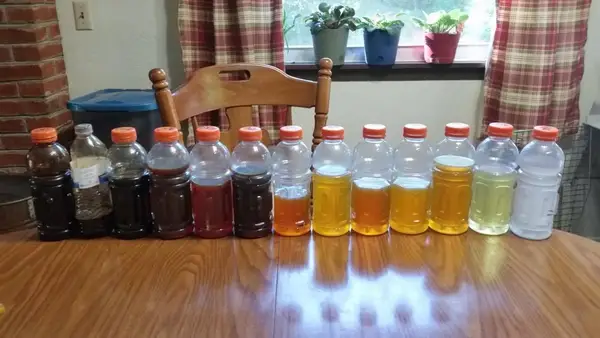The complex science behind crude oil is revealed in a spectrum of colours. Join us as we delve into the captivating realm of crude oil’s colour and uncover the secrets that lie beneath its surface. This vital resource explores the origins, factors, and impacts of colour.
The Origin of Color in Crude Oil
Have you ever wondered why crude oil comes in different colours? The origin of the colour in crude oil is a fascinating topic rooted in its complex composition. The colour of crude oil can vary from black to yellow depending on several factors, such as the presence of organic compounds like porphyrins and metal ions like nickel and vanadium. These components absorb light differently, resulting in the diverse hues we see. The geological formation process plays a significant role in determining the colour of crude oil. As it undergoes pressure, heat, and microbial action over millions of years, various chemical reactions occur that influence its colouration. Understanding the origin of this colour variation not only provides insights into the composition of crude oil but also aids in determining its quality and properties for refining purposes.
Factors Affecting the Color of Crude Oil
One key factor is the presence of impurities such as sulfur compounds and heavy metals, which can give crude oil a darker hue. The depth at which the oil is extracted from the earth can also influence its colour. Deeper reservoirs tend to contain darker oils due to increased exposure to heat and pressure over time. the age of the oil reservoir can impact its colour as well; older deposits often have a more pronounced dark colour compared to younger ones. Environmental conditions during formation and maturation processes contribute to variations in crude oil colour. Factors like temperature, pressure, and biological activity all leave their mark on the final pigment of this valuable commodity. So next time you see different shades of crude oil being transported or refined, remember that there’s a complex interplay of factors at play behind those captivating hues.
The Role of Chemical Composition in Color Variation
The chemical composition of crude oil plays a crucial role in its colour variation. The diverse mix of hydrocarbons present in crude oil plays a significant role in determining its colour. Different types of hydrocarbons absorb and reflect light differently, leading to variations in colour shades ranging from black to yellow or even green. For instance, asphaltene compounds can contribute to the darker hues seen in some oils.Oil’s sulfur content can also impact its colouration. Higher sulfur levels tend to result in a darker appearance due to light absorption properties. Impurities like nitrogen and oxygen compounds within crude oil can introduce additional colours, such as red or brown tones, depending on their concentration levels.Understanding how chemical components interact within crude oil provides valuable insights into why it displays a broad spectrum of colours across different sources and grades.
Analyzing the Color of Crude Oil: Spectroscopy and Chromatography
Have you ever wondered how scientists analyze the colour of crude oil? Spectroscopy and chromatography are two powerful techniques used in this fascinating process. Spectroscopy involves studying how light interacts with matter, providing valuable insights into the chemical composition of crude oil based on its colour. By measuring the absorption and emission of light, researchers can identify specific compounds present in the oil. On the other hand, complex mixtures like crude oil are separated into individual components for analysis. This technique helps determine the concentration of different molecules contributing to the overall colour of the oil sample. By combining these analytical methods, scientists can unlock a wealth of information about crude oil’s properties and quality. The colourful world of spectroscopy and chromatography plays a crucial role in understanding one of our most essential energy sources.
The impact of colour on the oil industry
The impact of colour on the oil industry is undeniable. Crude oil colour not only influences its market value but also plays a crucial role in refining processes. Understanding the science behind the colour of crude oil allows companies to optimize their operations, improve efficiency, and minimize costs. By analyzing the colour variations in crude oil through spectroscopy and chromatography, experts can determine its chemical composition and quality more accurately. This information helps in selecting the most suitable refining methods for different types of crude oil, ensuring maximum yield and product quality. Consumers are increasingly demanding cleaner and lighter products derived from refined crude oil. Therefore, by controlling and adjusting the colour of crude oil during processing, companies can meet these market demands while staying competitive in the industry. In essence, the colour of crude oil is not just a visual characteristic but a critical factor that impacts various aspects of the entire supply chain—from extraction to distribution. Embracing this understanding can lead to significant advancements in sustainability practices, technological innovations, and overall profitability within the dynamic landscape of the global oil industry.





